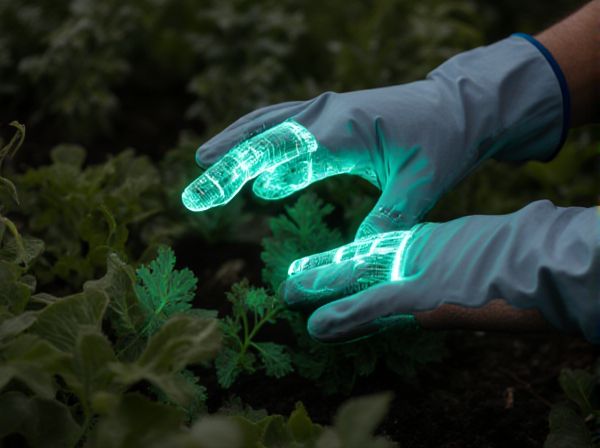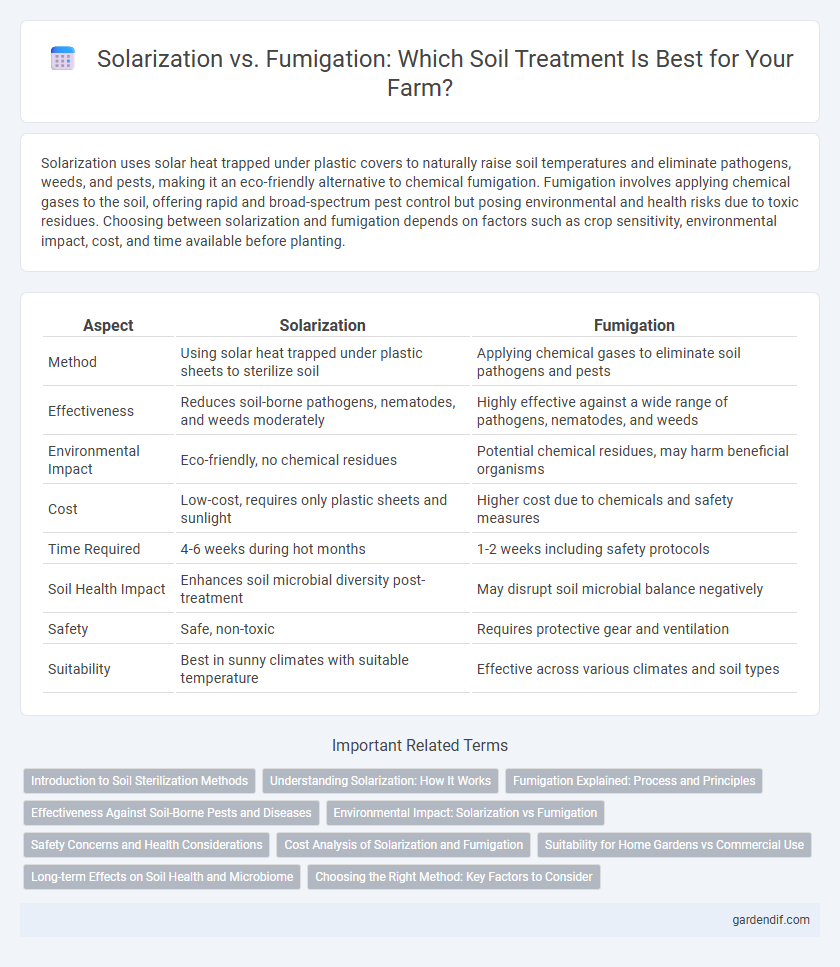
Solarization vs Fumigation Illustration
Solarization uses solar heat trapped under plastic covers to naturally raise soil temperatures and eliminate pathogens, weeds, and pests, making it an eco-friendly alternative to chemical fumigation. Fumigation involves applying chemical gases to the soil, offering rapid and broad-spectrum pest control but posing environmental and health risks due to toxic residues. Choosing between solarization and fumigation depends on factors such as crop sensitivity, environmental impact, cost, and time available before planting.
Table of Comparison
| Aspect | Solarization | Fumigation |
|---|---|---|
| Method | Using solar heat trapped under plastic sheets to sterilize soil | Applying chemical gases to eliminate soil pathogens and pests |
| Effectiveness | Reduces soil-borne pathogens, nematodes, and weeds moderately | Highly effective against a wide range of pathogens, nematodes, and weeds |
| Environmental Impact | Eco-friendly, no chemical residues | Potential chemical residues, may harm beneficial organisms |
| Cost | Low-cost, requires only plastic sheets and sunlight | Higher cost due to chemicals and safety measures |
| Time Required | 4-6 weeks during hot months | 1-2 weeks including safety protocols |
| Soil Health Impact | Enhances soil microbial diversity post-treatment | May disrupt soil microbial balance negatively |
| Safety | Safe, non-toxic | Requires protective gear and ventilation |
| Suitability | Best in sunny climates with suitable temperature | Effective across various climates and soil types |
Introduction to Soil Sterilization Methods
Soil sterilization methods such as solarization and fumigation effectively control soil-borne pathogens and pests to enhance crop health. Solarization uses solar heat trapped under transparent plastic to raise soil temperatures to 45-60degC, disrupting harmful microorganisms. Fumigation involves applying chemical fumigants like methyl bromide or chloropicrin, penetrating the soil to sterilize and eradicate a broader spectrum of biotic stressors.
Understanding Solarization: How It Works
Soil solarization uses solar energy to raise soil temperatures to levels that kill soilborne pathogens, pests, and weed seeds by covering moist soil with transparent plastic sheets during hot periods. This method relies on the greenhouse effect, trapping heat within the soil to achieve temperatures typically between 45degC and 60degC for several weeks, effectively sterilizing the soil. Unlike chemical fumigation, solarization is an eco-friendly, non-toxic approach that improves soil microbial activity and structure while suppressing harmful organisms.
Fumigation Explained: Process and Principles
Fumigation involves introducing gaseous pesticides into the soil to eradicate pests, pathogens, and weed seeds by penetrating the soil matrix. This process relies on sealing the treated area to contain the fumigant gas, ensuring optimal contact time and concentration for effective pest control. Key principles include choosing appropriate fumigants like methyl bromide or chloropicrin, understanding soil temperature and moisture conditions, and ensuring safety protocols to prevent environmental and human health risks.
Effectiveness Against Soil-Borne Pests and Diseases
Solarization effectively reduces soil-borne pests and diseases by using solar heat to eliminate pathogens, nematodes, and weed seeds, with success rates often exceeding 70-90% in warm, sunny climates. Fumigation offers rapid, broad-spectrum control of soil-borne pathogens, nematodes, and fungi through chemical agents like chloropicrin and methyl bromide, achieving near-complete pest eradication in treated areas. Solarization is environmentally friendly but slower, while fumigation provides immediate, intensive pest control with potential chemical residues.
Environmental Impact: Solarization vs Fumigation
Solarization uses solar energy to naturally heat soil, significantly reducing harmful pests and pathogens without chemical residues, making it environmentally friendly. Fumigation involves applying chemical fumigants that can contaminate air, water, and soil, posing risks to non-target organisms and contributing to environmental pollution. Solarization supports sustainable agriculture by minimizing ecological harm, whereas fumigation presents challenges in managing chemical exposure and environmental safety.
Safety Concerns and Health Considerations
Soil solarization offers a safer alternative to fumigation by using solar energy to raise soil temperatures, effectively reducing pests and pathogens without toxic chemicals. Fumigation involves chemical fumigants like methyl bromide, which pose significant health risks to handlers and nearby communities due to inhalation and toxicity. Solarization minimizes environmental contamination and worker exposure, making it a preferred method for sustainable soil pest management.
Cost Analysis of Solarization and Fumigation
Solarization incurs lower upfront costs, leveraging solar energy with minimal material expenses like transparent plastic covers, making it cost-effective for small to medium-sized farms. Fumigation requires substantial investment in chemical fumigants, specialized equipment, and safety protocols, leading to higher operational and regulatory compliance costs. Over time, solarization reduces expenses related to chemical handling and environmental impact, whereas fumigation may entail recurring costs due to potential soil health degradation and pest resistance.
Suitability for Home Gardens vs Commercial Use
Soil solarization is highly suitable for home gardens due to its simplicity, safety, and cost-effectiveness, using clear plastic covers to trap solar radiation and eliminate soil pathogens without harmful chemicals. In contrast, fumigation is more appropriate for commercial use where larger-scale, rapid, and intensive pest and disease control is required, despite being more expensive and involving hazardous chemicals. Solarization favors small-scale, organic-friendly environments, whereas fumigation meets the demands of high-value crop production and extensive agricultural operations.
Long-term Effects on Soil Health and Microbiome
Soil solarization enhances long-term soil health by increasing beneficial microbial activity and suppressing soilborne pathogens through natural heat, promoting a balanced microbiome. Fumigation provides rapid pathogen control but often disrupts microbial diversity and may lead to reduced soil resilience over time. Sustainable soil management favors solarization for preserving microbial ecosystems vital for nutrient cycling and plant growth.
Choosing the Right Method: Key Factors to Consider
Choosing the right soil treatment method depends on factors such as soil type, pest severity, crop sensitivity, and environmental impact. Solarization is ideal for warmer climates and organic farming due to its chemical-free nature and ability to reduce soil-borne pathogens through solar heat. Fumigation provides fast, broad-spectrum pest control but requires careful handling due to toxic chemicals and may affect soil microbial health.
Solarization vs Fumigation Infographic

 gardendif.com
gardendif.com